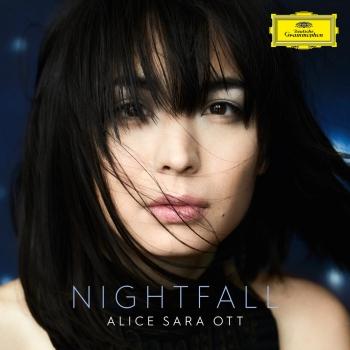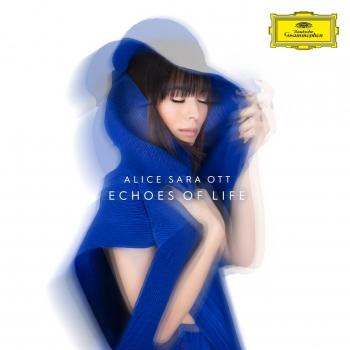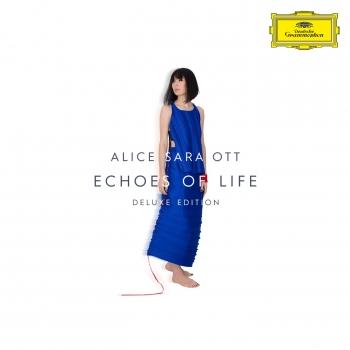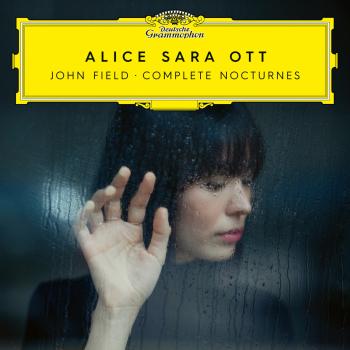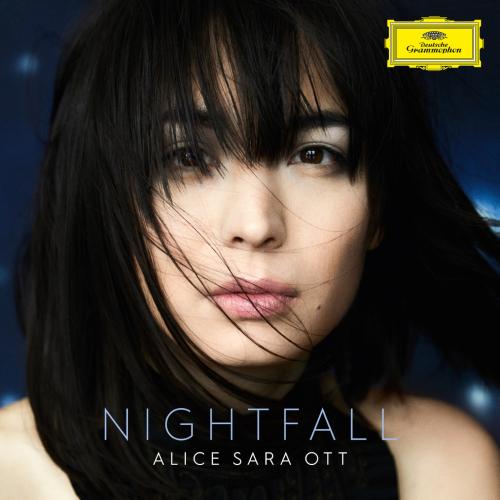
Nightfall Alice Sara Ott
Album info
Album-Release:
2018
HRA-Release:
24.08.2018
Label: Deutsche Grammophon
Genre: Classical
Subgenre: Instrumental
Artist: Alice Sara Ott
Composer: Maurice Ravel (1875-1937), Erik Satie (1866-1925), Claude Debussy (1862-1918)
Album including Album cover Booklet (PDF)
I`m sorry!
Dear HIGHRESAUDIO Visitor,
due to territorial constraints and also different releases dates in each country you currently can`t purchase this album. We are updating our release dates twice a week. So, please feel free to check from time-to-time, if the album is available for your country.
We suggest, that you bookmark the album and use our Short List function.
Thank you for your understanding and patience.
Yours sincerely, HIGHRESAUDIO
- Claude Debussy (1862-1918):
- 1 Rêverie, L. 68 04:45
- Suite bergamasque, L. 75:
- 2 1. Prélude 04:19
- 3 2. Menuet 04:24
- 4 3. Clair de lune 04:55
- 5 4. Passepied 03:50
- Erik Satie (1866-1925): Gnossiennes:
- 6 1. Lent 04:18
- 3 Gymnopédies:
- 7 1. Lent et douloureux 03:25
- Gnossiennes:
- 8 3. Lent 02:56
- Maurice Ravel (1875-1937): Gaspard de la nuit, M. 55:
- 9 1. Ondine 06:50
- 10 2. Le Gibet 09:20
- 11 3. Scarbo 10:14
- Pavane pour une infante défunte, M. 19:
- 12 Pavane pour une infante défunte, M. 19 06:54
Info for Nightfall
Alice Sara Ott presents Nightfall, where she explores the transition and harmony between day and night, light and darkness. This recording showcases a collection of deeply emotional piano pieces by Satie, Debussy and Ravel.
On her new album Nightfall, set for release by the Yellow Label on 24 August 2018, Alice Sara Ott takes a very personal look at the magical moment in time and space between day and night, light and darkness, basing her explorations on works by Debussy, Satie and Ravel. The German-Japanese pianist decided to mark the dual celebration of her 30th birthday and her 10th anniversary as a Deutsche Grammophon artist by examining her relationship with three French composers who have had a significant influence on her, and whose music made an indelible impression on the Parisian arts scene at the turn of the 20th century. With meticulous attention to detail, she traces the shifting moods in these works, revealing the fascinating interplay of the light and dark tones used by Debussy, Satie and Ravel to create such wide-ranging atmospheres.
Ending and beginning, transparency and opacity. As day turns to night and light fades into darkness, we enter the blue hour of twilight, when the air seems full of mystery, fleetingly saturated in blue and purple hues before inexorably darkening to blackness. It is precisely this elusive change in atmosphere that Alice Sara Ott sets out to capture in musical terms on Nightfall. The album is a particularly personal artistic project for Alice Sara Ott, documenting the intensity of her musical encounters with these three composers.
Debussy, Satie and Ravel were contemporaries, and all three lived, worked and died in Paris. They were friends, but also rivals, each writing in his own very individual style. As a result, we hear the contrast between the dreaminess of Debussy’s Rêverie (1890), written when the young composer was still in search of his own stylistic ideas; the dark, romantic and intricate storytelling of Ravel’s Gaspard de la nuit (1908); and the minimalistic snapshots of Satie’s Gymnopédies and Gnossiennes (1888–90). Debussy’s dance-based Suite bergamasque was published in 1905, and Ott sees its most famous movement, “Clair de lune” – inspired by the Verlaine poem of the same name – as reflecting the way people don masks of happiness to disguise their pain. As for Ravel’s Pavane pour une infante défunte of 1899, she suggests it may be about the quest for eternal youth.
This album gives us a glimpse of the artist’s thought process, which goes beyond consideration of the musico-historical significance of the works in question, beyond her artistic interpretation of the scores and her desire for technical perfection. On a higher, more abstract level, her readings of the shimmering ambiguities central to these works mirror the dichotomy of all human emotions, as well as shining a light on her personal fascination with the psychological fissures and contradictions that mark each and every one of us, and which are just as hard to capture as the changing moods of the complex, filigree music of Debussy, Satie and Ravel.
Tokyo-based French director Julien Lévy has made music videos to accompany the release of Nightfall.
Alice Sara Ott, piano
Alice Sara Ott
In less than five years, the twenty-five year old German-Japanese pianist Alice Sara Ott has gained critical acclaim for her performances at major concert halls worldwide and has established herself as one of the most exciting musical talents of today.
Recent concerts have seen Alice perform with the Münchner Philharmoniker in Munich and the NHK Symphony Orchestra in Tokyo, both under Lorin Maazel, and a very successful European tour with the Czech Philharmonic Orchestra under Krzysztof Urbański. In recital, she had great success with her recitals in London’s International Piano Series, Chicago Symphony Center, New York’s Le Poisson Rouge, Hamburg’s Laeiszhalle and Berlin’s Kammermusiksaal.
Highlights of the 2013/14 season include appearances with the Philharmonia Orchestra (Vladimir Ashkenazy), Washington’s National Symphony Orchestra (Neeme Järvi), Chamber Orchestra of Europe (Thomas Dausgaard) and tours with Finnish Radio Symphony Orchestra (Hannu Lintu), Oslo Philharmonic Orchestra (Vasily Petrenko) and Orchestre Philharmonique de Radio France (Myung-Whun Chung). In recital, she makes return visits to Beethovensaal in Stuttgart, Prinzregententheater in Munich and Vienna’s Konzerthaus.
In previous seasons she has appeared with the Royal Stockholm Philharmonic Orchestra (Sakari Oramo), London Symphony Orchestra (Daniel Harding), San Francisco Symphony (Pablo Heras-Casado), Danish National Symphony Orchestra (Robin Ticciati), Philharmonia Orchestra (Leif Segerstam), and hr-Sinfonieorchester (Paavo Järvi).
Alice has recorded exclusively for Deutsche Grammophon since 2008, with her highly successful debut recording of Liszt’s 12 Études d’exécution transcendante quickly followed by a second album of Chopin’s complete waltzes, entering both the German and US Classical iTunes charts at No.1. Alice’s debut concerto album, with works by Tchaikovsky and Liszt (with the Münchner Philharmoniker and Thomas Hengelbrock) was named Editor’s Choice in both International Piano and Classic FM magazines. Alice was also awarded the prize for Young Artist of the Year at the Echo Klassik Awards for her Chopin recording in October 2010. Her performance of Mussorgsky’s Pictures from an Exhibition at the Mariinsky Theatre, was recorded live in July 2012 during the White Nights Festival in St Petersburg and was released in January 2013. Upcoming recording projects include a two piano programme based on Russian ballet with Francesco Tristano in autumn 2013, and which will be on worldwide tour in 2014/15 season.
Francesco Tristano
a young musician and composer causing a stir on the club scene as well as in classical concert venues is probably a world-first. It may also be the first time that purists from the classical and techno camps actually agree on something – That they don’t know quite what to make of this young musician who refuses to stick to the rules. For Francesco Tristano this kind of reaction is nothing new. Experienced concert audiences and classical music lovers may feel equally baffled when they hear a pianist blend and mix his own composition – just like a DJ – into a piece by baroque composer Girolamo Frescobaldi…
The intrepidness with Francesco Tristano combines eras and styles, occasionally allowing them to collide, may initially create a baffled response. However, Luxembourg-born Tristano has no aspirations as an agitator. Almost everything he does is an expression of an open-minded attitude which refuses to accept borders and constrictions. Tristano knows all about the interpretational conventions that have shaped generations of classical pianists – and he has chosen to ignore them. He does not seek approval as an artist and when his dynamic performance emotively basks in the intrinsic severity of Old music – that’s when he’s truly radical.
Tristano, born in 1981, discovered the piano at the age of five. Aged 13, he played his first concert, presenting his own compositions. He later toured both as a soloist and with renowned orchestras, such as the Russian National Orchestra, the Deutsches Symphonie-Orchester Berlin, and the Hanoi Philharmonic Orchestra among others. Tristano founded his chamber ensemble, The New Bach Players which he also conducts. This ensemble consciously breaks with conventions, using a modern grand piano and old, vibratoless bows on contemporary string instruments.
Tristano visited New York’s Juilliard School during five years. The city of New York opened his ears to electronic and club music. to complete Bach legend Rosalyn Tureck’s master class. In 2004, he won the first prize at the International piano competition for contemporary music in Orléans, France. Tristano has released twelve albums, among them recordings of Bach Goldberg Variations and complete keyboard concertos, Luciano Berio complete piano works, and Girolamo Frescobaldi Toccatas. ‘Not for Piano’ (inFine, 2007), presented his own compositions as well as versions of techno classics at the piano. ‘Idiosynkrasia’ (inFine, 2010), recorded at Carl Craig’s Planet E-communications in Detroit, was released to critical acclaim in 2010. Tristano is a Deutsche Grammophon artist and is about to release his third album on that label. His ‘bachCage’, produced by Moritz von Oswald, was released on DGG in 2011. His collaborative tracks and remixes have been released on labels such as Innervisions, CLR, Visionquest, PIAS and Inflyte.
Booklet for Nightfall











